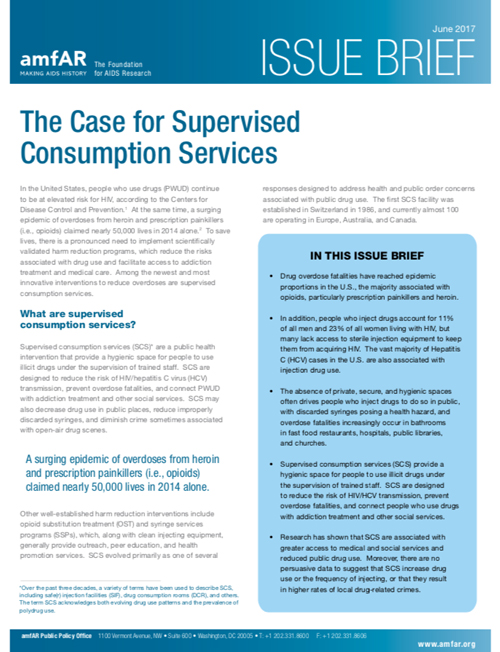In the United States, people who use drugs (PWUD) continue to be at elevated risk for HIV, according to the Centers for Disease Control and Prevention. At the same time, a surging epidemic of overdoses from heroin and prescription painkillers (i.e., opioids) claimed nearly 50,000 lives in 2014 alone. To save lives, there is a pronounced need to implement scientically validated harm reduction programs, which reduce the risks associated with drug use and facilitate access to addiction treatment and medical care. Among the newest and most innovative interventions to reduce overdoses are supervised consumption services.
In This Issue Brief
• Drug overdose fatalities have reached epidemic
proportions in the U.S., the majority associated with
opioids, particularly prescription painkillers and heroin.
• In addition, people who inject drugs account for 11% of all men and 23% of all women living with HIV, but
many lack access to sterile injection equipment to keep
them from acquiring HIV. The vast majority of Hepatitis
C (HCV) cases in the U.S. are also associated with
injection drug use.
• The absence of private, secure, and hygienic spaces
often drives people who inject drugs to do so in public,
with discarded syringes posing a health hazard, and
overdose fatalities increasingly occur in bathrooms
in fast food restaurants, hospitals, public libraries,
and churches.
• Supervised consumption services (SCS) provide a
hygienic space for people to use illicit drugs under
the supervision of trained staff. SCS are designed
to reduce the risk of HIV/HCV transmission, prevent
overdose fatalities, and connect people who use drugs
with addiction treatment and other social services.
• Research has shown that SCS are associated with
greater access to medical and social services and
reduced public drug use. Moreover, there are no
persuasive data to suggest that SCS increase drug
use or the frequency of injecting, or that they result
in higher rates of local drug-related crimes.
Download the complete issue brief in PDF format by clicking here or on the image below.
